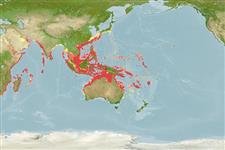Classification / Names
Common names from other countries
Main reference
Size / Weight / Age
Max length : 47.0 cm TL male/unsexed; (Ref. 27266); common length : 35.0 cm TL male/unsexed; (Ref. 5450); max. published weight: 1.4 kg (Ref. 27266); max. reported age: 15 years (Ref. 27352)
Length at first maturity
Lm 20.0, range 19 - ? cm
Environment
Marine; reef-associated; depth range 6 - 200 m (Ref. 2334)
Climate / Range
Tropical, preferred 28°C (Ref. 107945); 35°N - 33°S, 29°E - 180°E (Ref. 5222)
Distribution
Indo-Pacific: Red Sea and the Persian Gulf to Natal, South Africa and east to Fiji, north to Japan, south to the Arafura Sea (Ref. 9819) and northern Australia. Recently recorded from Tonga (Ref. 53797). Appears to be absent from Micronesia, Polynesia, and most islands of the western Indian Ocean. Often confused with Epinephelus chlorostigma.
Countries | FAO areas | Ecosystems | Occurrences | Introductions
Short description
Dorsal
spines
(total): 11;
Dorsal
soft rays
(total): 15-17;
Anal
spines: 3;
Anal
soft rays: 8. Characterized by grey to whitish color with numerous close-set orange to brown spots, becoming smaller and increase in number as growth increases; narrow white margin on tail; body scales ctenoid, cycloid scales on thorax and ventrally on abdomen; body with auxiliary scales; moderately elongate body, greatest depth 2.7-3.3 in SL; truncate or slightly emarginate caudal fin; pelvic fins 1.6-2.1 in head length (Ref. 90102).
IUCN Red List Status (Ref. 115185)
Threat to humans
Harmless
Human uses
Fisheries: commercial; aquaculture: commercial
Tools
Special reports
Download XML
Internet sources
Estimates of some properties based on models
Phylogenetic diversity index
PD50 = 0.5000 many relatives (e.g. carps) 0.5 - 2.0 few relatives (e.g. lungfishes)
Trophic Level
3.7 ±0.3 se; Based on diet studies.
Resilience
Low, minimum population doubling time 4.5 - 14 years (K=0.31; tm=2; tmax=25; Fec = 22,128)
Vulnerability
Moderate vulnerability (36 of 100)
Price category
